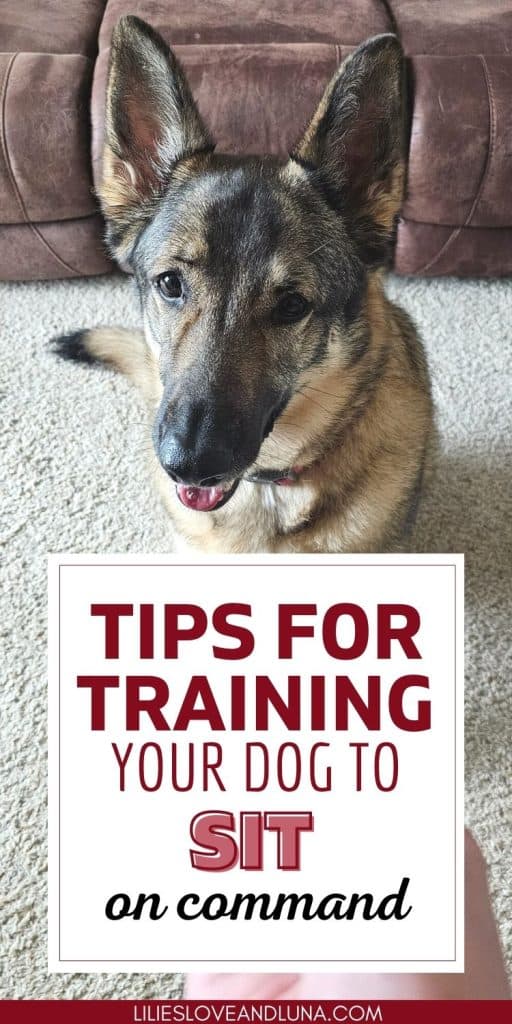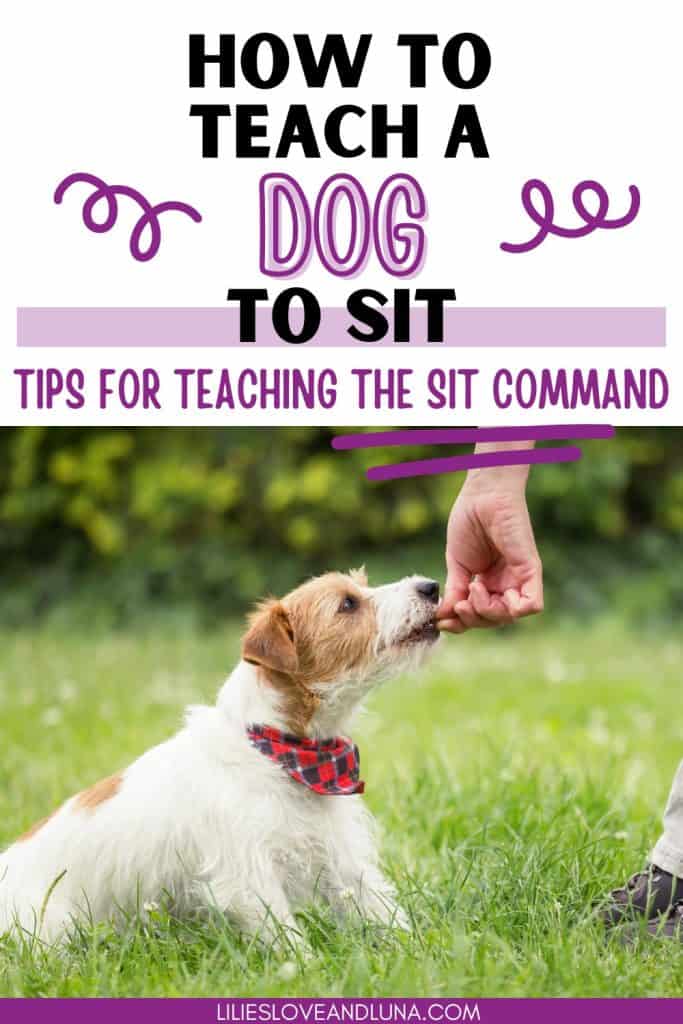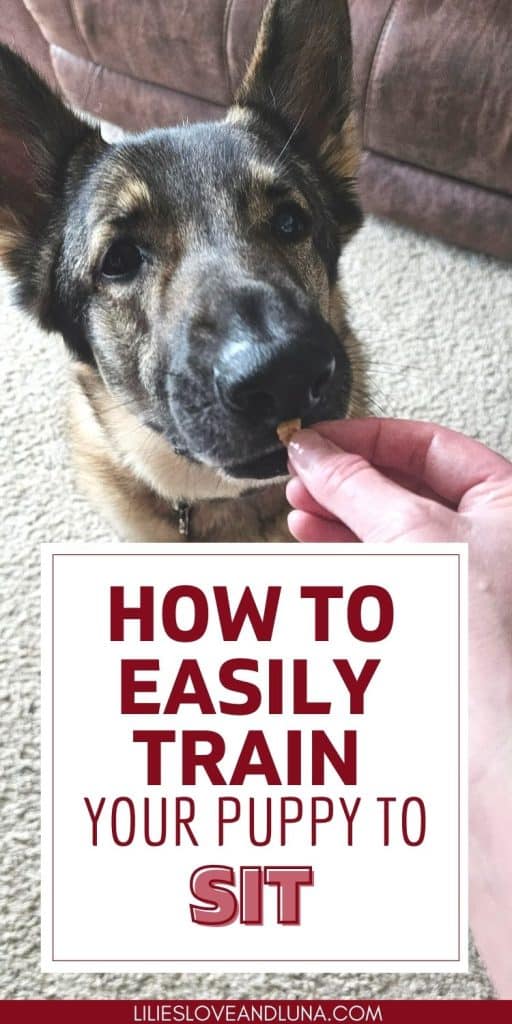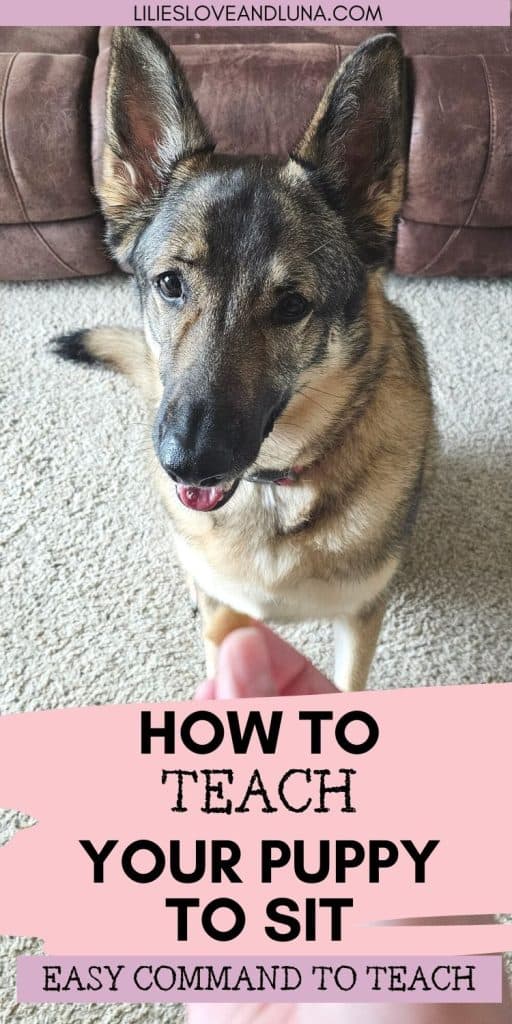Teaching your puppy to sit is one of the easiest and most important behaviors to train.
A solid sit is the foundation for many other important skills, like down and stay.
Teaching your new puppy to sit can be a fun and rewarding time for both you and your puppy.
With just a few minutes of training every day, your puppy will master this fundamental building block and be on their way to a well-trained dog.
A well-trained dog is a joy to have, so let’s get started on teaching your puppy this essential life skill!
The key is to have patience, keep sessions brief and rewarding, and set your puppy up for success every step of the way.
Teaching a reliable sit is easier than you think!
This post may contain affiliate links. That means if you click on them and buy something, I may receive a small commission at no cost to you. Read my Disclaimer Policy to learn more.
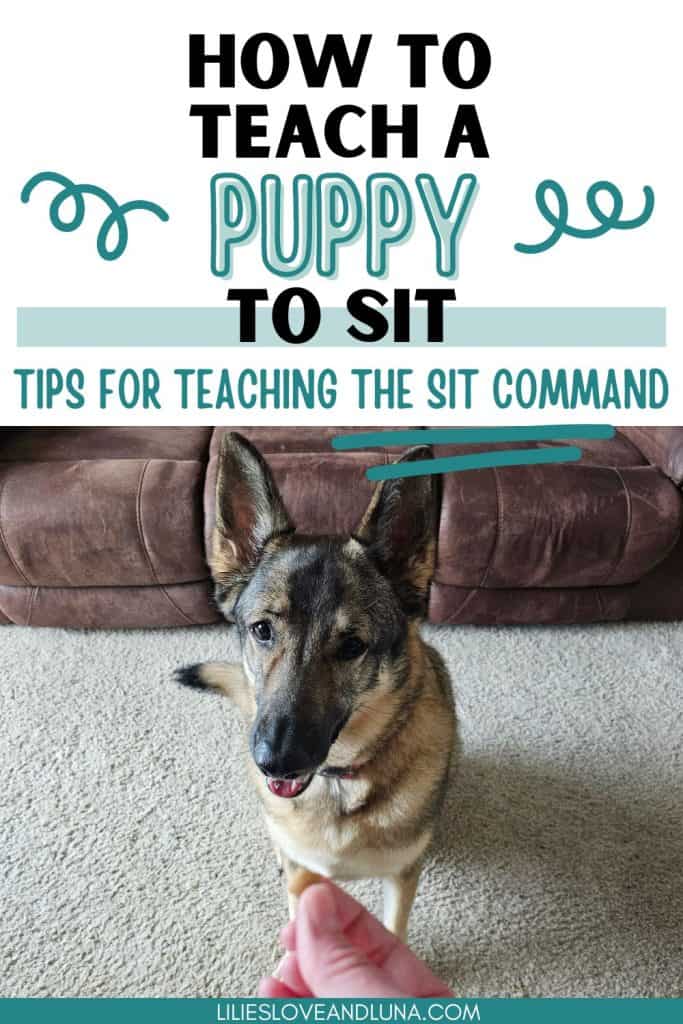
Benefits of teaching your dog to sit
Teaching your dog to sit has several benefits:
- It’s a great way to strengthen your bond with your dog.
- It helps build impulse control and obedience. Having your dog sit before things like eating, going outside, or receiving affection can reinforce good manners.
- It provides a way to get your dog’s attention focused on you if they are distracted or over-excited. Requiring a sit first helps calm your dog down.
- A solid sit can help keep your dog from jumping up on people (though many dogs require training specific to jumping up along with sit training).
- It provides a foundation for more advanced training. A reliable sit can be built upon for other important behaviors like down and stay.
- It gives your dog an easy way to earn rewards and praise. Regularly reinforcing the sit keeps your dog engaged and willing to learn.
Simply put, sit gives you a convenient, non-confrontational way to halt behavior you don’t want while encouraging behavior you do want.
It is also one of the easiest commands to teach a puppy.
Sit training supplies
Sit training requires just a few supplies:
- Your dog’s favorite treats or training treats
- Your dog’s favorite toy
- A leash
- A clicker (only if you want to clicker train your dog)
Depending on your dog or puppy, you may not need all of these supplies.
If your dog is not play-motivated, the toy may not be needed.
And when training indoors, a leash is unnecessary unless your puppy wanders off during training.
How to teach your dog to sit
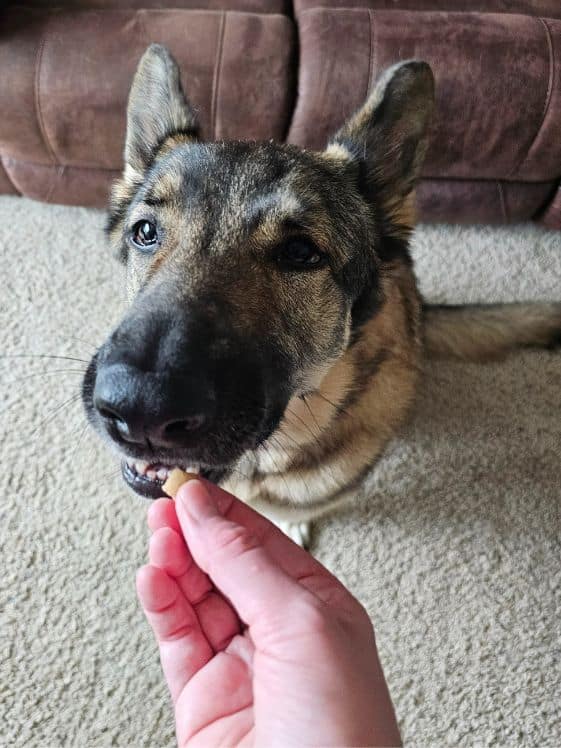
The best way to teach your dog or puppy to sit is to use positive reinforcement and lure training.
Lure training how to sit involves just a few steps and relies on your puppy’s desire to get the reward.
For most puppies, this reward is a food treat, but if your puppy isn’t food-motivated, you can try using a favorite toy instead.
Then the reward is a short play session instead of a treat to eat.
Create the right environment
First, you want to create the right environment to teach your puppy how to sit.
This creates an area that is conducive to learning and allows you and your puppy to focus on the task at hand.
When you first start training your puppy to sit, you want a space that is indoors.
Inside the house is much less distracting to your puppy than all the smells outside.
Once your puppy is doing good with their sit, then you can move outside.
Other than staying inside, you want the area you are in as free from distractions as possible.
Busy rooms with a lot of activity may make it difficult for your puppy to stay attentive.
And an inattentive puppy is setting yourself, and your puppy, up for failure.
A calm, quiet indoor area will set your puppy up for success with their training.
Lure your dog into a sit position
Once you have chosen your location, it’s time to start the actual training process by luring your puppy into a sit position.
To do this start by being in front of your dog with a small, tasty treat in one hand, held between your thumb and fingers.
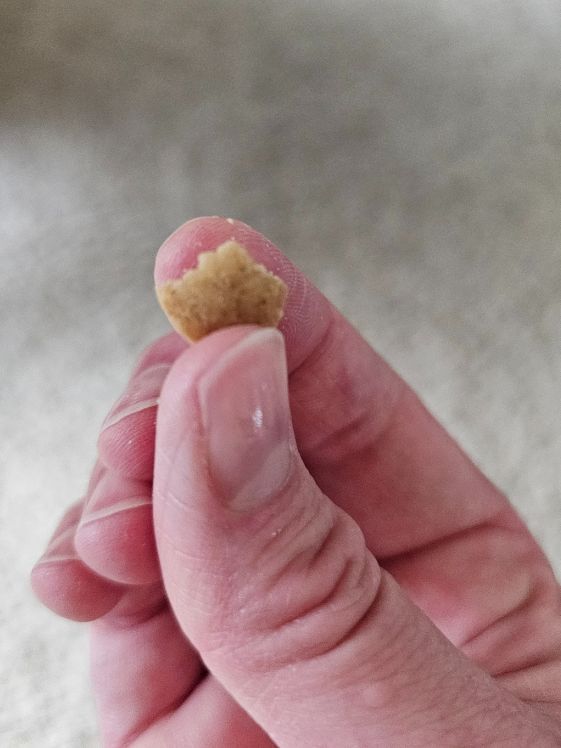
Have your puppy in a standing position and then place the treat near your dog’s nose.
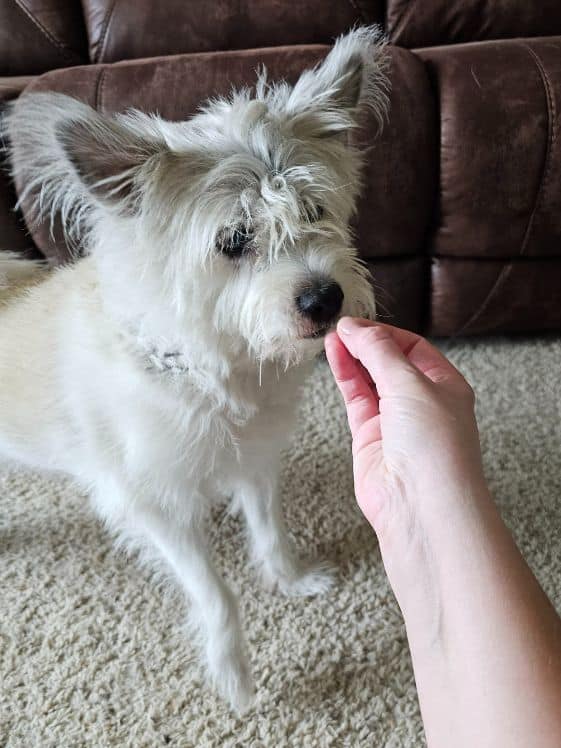
Slowly raise it in an arc toward your dog’s forehead.
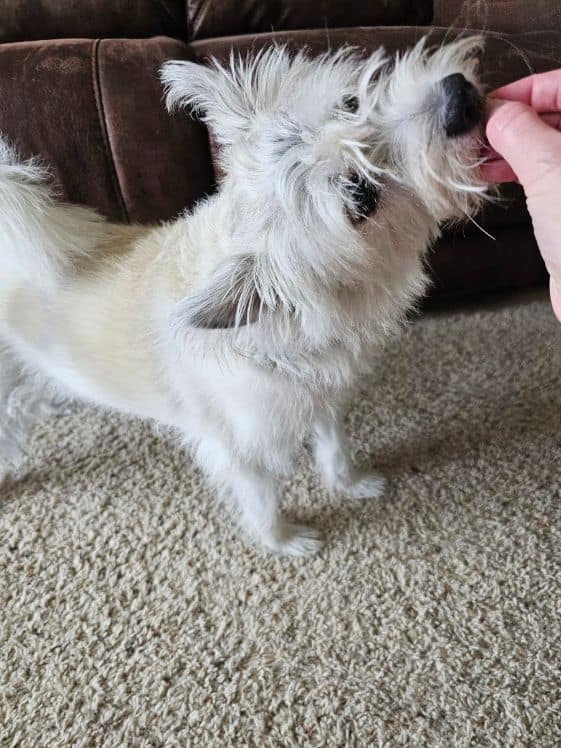
Your puppy should follow the treat with their nose which will naturally cause their butt to go down.
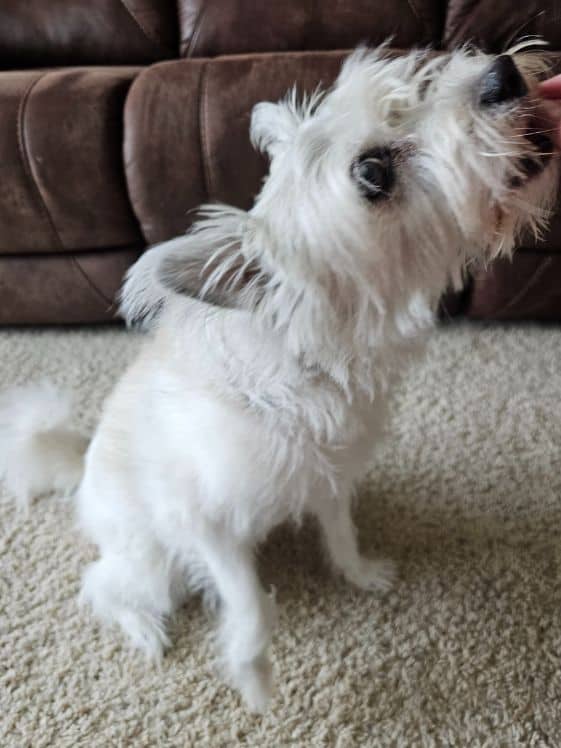
Once their butt touches the ground and they are in the sitting position, say “yes” or “good boy/girl” in a happy tone and give them the treat.
You want to try to catch the second their butt hits the ground with your positive verbal reinforcement and follow with the treat as quickly as you can.
Practice multiple times and keep the session short, around 5 to 10 minutes at a time, to keep your puppy engaged.
Add the verbal cue
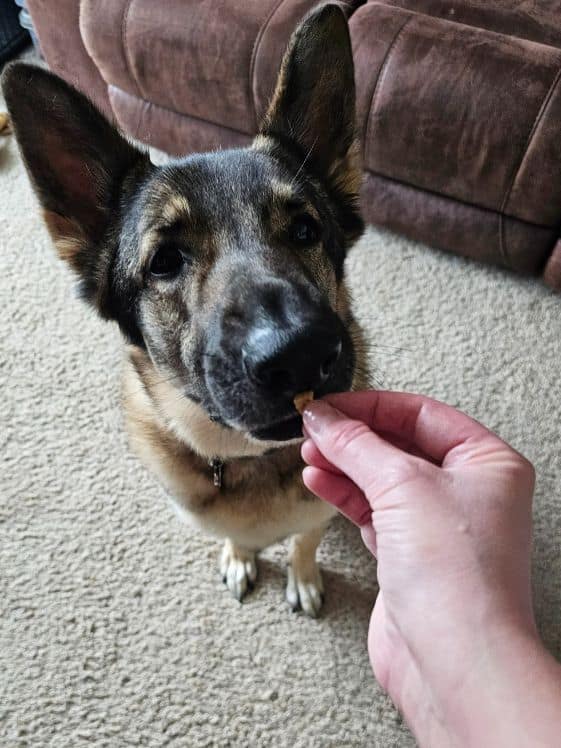
Once your puppy has sat a few times with just the lure training you can start adding in the verbal command “sit.”
To do this, just say the word “sit” in a calm voice right when your puppy’s butt touches the floor.
Then use the cue word every time you practice with the treat.
Eventually, your puppy will make the connection between the word and the treat.
Phase out the lure
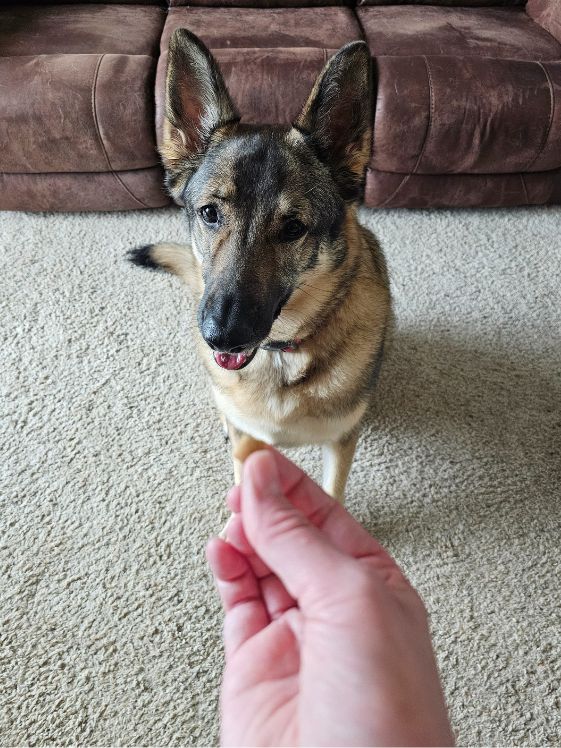
As your puppy gets better at following the lure you can gradually fade the lure out.
To do this, start with luring with a treat in one hand and rewarding with a treat from the other hand.
Then start luring with an empty hand and continue to reward with a treat from the other hand.
Once your puppy is regularly following the lure without a treat, start switching to just using the hand signal instead of the lure.
The hand signal is the same motion as luring with a treat but not right by your puppy’s nose.
Phase out the treats
Once your puppy is regularly doing a sit with treats but not being lured, start phasing out the treats.
To phase out the treats you stop giving a treat for every sit and start giving treats randomly when your puppy sits when asked.
You still want to give verbal praise every time they sit, just reduce the treats.
As you reduce the treats start with giving more treats than not treats and slowly increase the number of sits that get just verbal praise and no treats.
Advancing with distractions and different locations
Once your puppy is doing a sit regularly with irregular treats, it’s time to up the difficulty and add in distractions and different settings.
Adding in distractions and different environments helps your puppy become more comfortable and confident in various situations.
It’s important to introduce distractions gradually, as overwhelming your puppy can hinder their progress.
Start with adding in low-level distractions and slowly increase the intensity.
For example, begin practicing the sit command with having a toy nearby.
As your puppy becomes more comfortable, you can try moving the toy and then tossing the toy.
Then start having someone walk by or introduce other pets into the room.
Once your puppy is good with distractions, start practicing in different locations in the house and then move to practicing outdoors.
When you change the location, try to limit the distractions as much as possible until your puppy is consistently doing a sit in the new location.
Then add in some distractions in the new environment.
When adding in new locations, start in familiar areas like other rooms in your house, near an open door, and the backyard.
Once your puppy can consistently sit in these spaces, move to more challenging environments like sidewalks, the dog park, or even pet-friendly stores.
Here are some key points to remember while advancing with distractions and different environments:
- Gradually increase the level of distractions
- Practice in familiar spaces first before moving to more challenging environments
- Consistency and repetition are essential with each step of the training process.
By incorporating distractions and different environments into your puppy’s sit training, you’re not only helping them to listen better but also providing opportunities for important socialization experiences.
Keep a positive tone of voice, be patient, and remember that practice makes perfect.
Things to Avoid
When training your puppy to sit, there are a few things to avoid.
- Don’t punish or yell if the puppy doesn’t sit. This will just teach them to be afraid of you and damage the bonding process. Always use positive reinforcement.
- Don’t repeat the cue “sit” over and over. Say it once, give them a chance to comply, and if they don’t, gently guide them into a sit position with a lure.
- Don’t rush the training or do too many repetitions. Puppies have short attention spans. Keep sessions short, positive, and rewarding.
- Don’t require long durations in the sit position. At first just reward for a brief sit, then you can work up to longer durations.
- Don’t use treats that are difficult to eat or too large. This can become distracting for the puppy. Use soft, bite-sized treats.
- Don’t start training how to sit in an area with too many distractions. Have training sessions in a quiet room at first to set the puppy up for success.
- Don’t end on a failure. If the puppy is getting restless or not responding, end the session on a positive note by asking for and rewarding something your puppy can do easily.
Training Sessions and Duration
When teaching your puppy to sit, it’s essential to consider your dog’s attention span and be patient with their learning process.
A key aspect of effective training involves conducting brief and frequent sessions.
Ideally, keep sessions between 5-10 minutes, as puppies have short attention spans and can get bored or tired quickly.
By keeping them engaged for a short period, you maximize their chances of retaining the information taught during training.
Remember to make these sessions a positive and fun experience, ensuring your puppy associates learning with excitement and rewards.
It’s also important to maintain consistency in your training schedule.
Aim for one or two daily sessions, as frequent training tends to yield faster results.
How to teach an older dog to sit
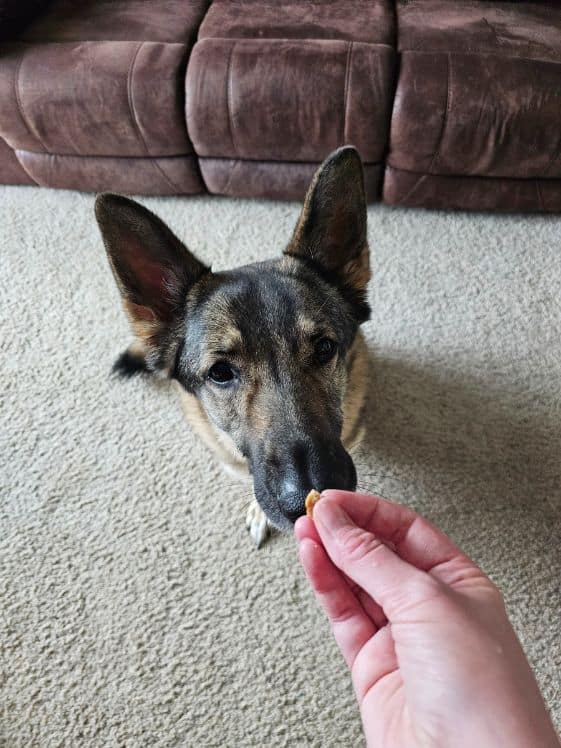
Teaching an adult dog to sit is the same process as teaching a puppy.
The only difference is that older dogs are sometimes less distractable than puppies but you do have to work with any established behaviors that they learned before coming to you.
Some older dogs will be easier to train, but others may be more difficult depending on what life has already thrown at them.
The most important thing to remember when teaching an older dog to sit is to be patient.
Frequently Asked Questions
When should you start training your puppy to sit?
It’s never too early to start training your puppy, and you can begin teaching basic commands like “sit” as soon as you bring your new puppy home.
What are the first 5 commands to teach a puppy?
The first 5 basic commands to teach your puppy are: sit, down, leave it, stay, and come.
What is the first thing you should teach a puppy?
The first thing you should teach your puppy is their name.
When your puppy hears their name and looks at you, they are giving you their attention.
This creates a foundation for further training and helps in developing a strong bond between you and your puppy.
How can I teach a dog to sit from the “down” position?
To teach a dog to sit from the “down” position, you first want them to know how to sit from a standing position.
Then, when they are in the down position, use a treat to lure their head upwards and backwards. This should cause their front end to rise up into a sit.
How long does it take to teach a puppy to learn how to sit?
The length of time it takes a puppy to learn how to sit can vary and depends on how often you are training them.
Most puppies will learn the sit command within a few days to a few weeks with consistent daily practice.
Related Posts
How To Potty Train Your New Puppy
How to Teach a Dog to Play the Game of Tug of War
How To Teach Your Dog The Find It Game
